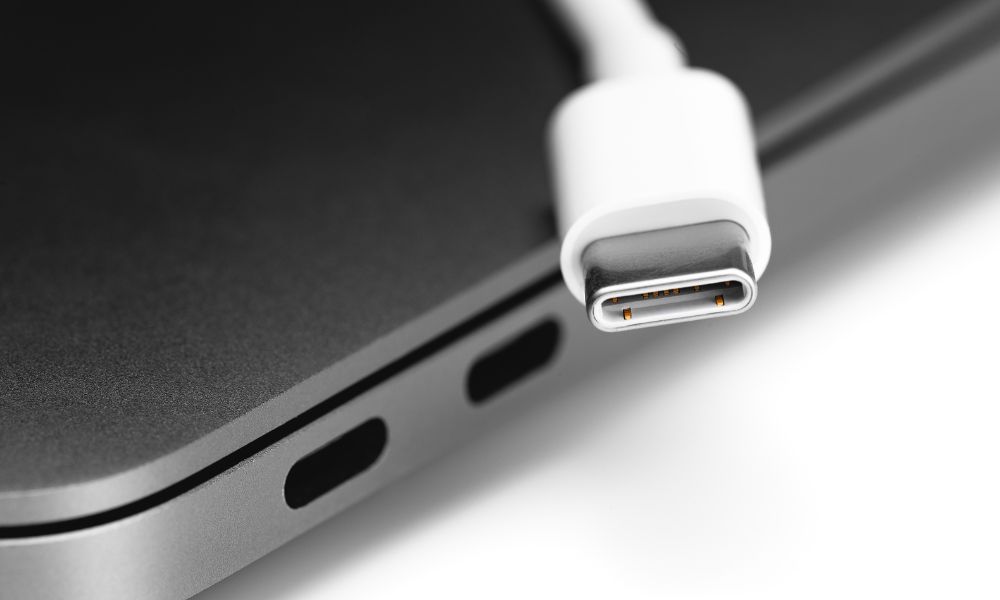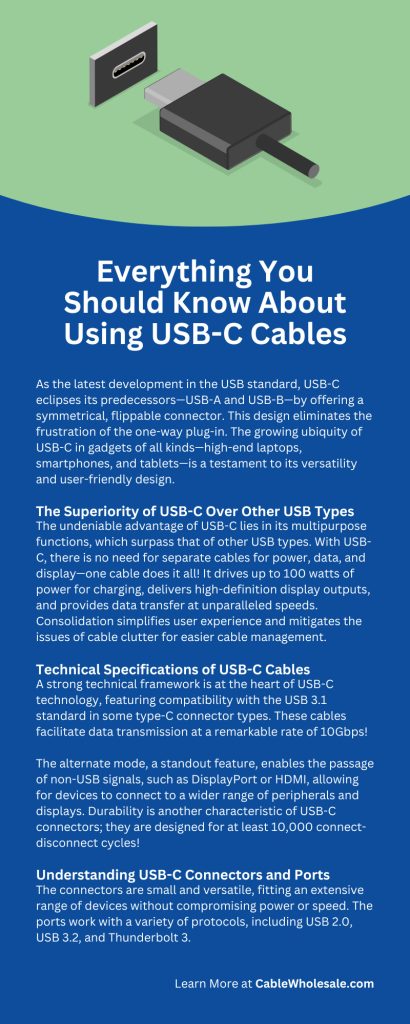
USB-C cables revolutionized how we connect devices by offering a universal charging and data transfer solution that streamlines technological interactions. Understanding the capabilities and advantages of USB-C cables enhances your workflow and device interoperability while preparing you for the future of connectivity. Discover everything you should know about using USB-C cables, and improve the way you power, transfer, and listen in your network.
Introduction to USB-C Cables
As the latest development in the USB standard, USB-C eclipses its predecessors—USB-A and USB-B—by offering a symmetrical, flippable connector. This design eliminates the frustration of the one-way plug-in. The growing ubiquity of USB-C in gadgets of all kinds—high-end laptops, smartphones, and tablets—is a testament to its versatility and user-friendly design. This technology is a clear shift from the varied, often incompatible connectors of the past.
The adoption of USB-C by countless tech companies and standardization bodies in technology, business, and entertainment positions it as the port of choice. This indicates an evolutionary leap in connectivity solutions. The powerful interface combines power delivery, video output, and data transfer in a single cable, encapsulating the essence of technological advancement and usability that defined the last decade.
The Superiority of USB-C Over Other USB Types
The undeniable advantage of USB-C lies in its multipurpose functions, which surpass that of other USB types. With USB-C, there is no need for separate cables for power, data, and display—one cable does it all! It drives up to 100 watts of power for charging, delivers high-definition display outputs, and provides data transfer at unparalleled speeds. Consolidation simplifies user experience and mitigates the issues of cable clutter for easier cable management.
Additionally, USB-C’s bidirectional power capability permits two-way charging, allowing devices to act as hosts and receivers while charging other USB-C-compatible gadgets. By adopting USB-C, consumers and manufacturers foster compatibility and pave the way for innovation in the tech industry.
Technical Specifications of USB-C Cables
A strong technical framework is at the heart of USB-C technology, featuring compatibility with the USB 3.1 standard in some type-C connector types. These cables facilitate data transmission at a remarkable rate of 10Gbps!
The alternate mode, a standout feature, enables the passage of non-USB signals, such as DisplayPort or HDMI, allowing for devices to connect to a wider range of peripherals and displays. Durability is another characteristic of USB-C connectors; they are designed for at least 10,000 connect-disconnect cycles!
Finally, integrating E-Marker chips within cables enhances function by enabling active cable management. These smart chips identify the ideal power delivery and adjust accordingly for efficiency and safety.
Understanding USB-C Connectors and Ports
USB-C connectors and ports showcase a remarkable cohesion of design and functionality that meet the high standards of modern technology. The connectors are small and versatile, fitting an extensive range of devices without compromising power or speed. The ports work with a variety of protocols, including USB 2.0, USB 3.2, and Thunderbolt 3.
This forward-thinking design enhances the user experience and solidifies USB-C’s position as the future-proof data and power connection standard.
The Role of USB-C in Data Transfer
The prominence of USB-C in expediting data transfer is second to none nowadays. With its advanced data transfer capabilities, USB-C facilitates the swift and reliable movement of large volumes of data. This capability is essential for professionals who manage complex and data-intensive tasks daily.
The integration of the USB 3.1 Gen 2 standard allows USB-C to perform twice as fast as its predecessor. It is an influential asset in modern technology. Adopting USB-C could propel your data management strategies to new stages of operational success.
USB-C Power Delivery
USB-C’s power delivery (PD) specification is a game-changer in charging technology. It can safely deliver high voltage to a wide array of devices. This revolutionary feature powers laptops, tablets, and other electronics, negating the need for various chargers and leading the way to a universal charging standard. With the capacity to provide up to 100W of power, USB-C PD offers rapid charging for various gadgets.
Video Output Capabilities of USB-C
USB-C’s capacity for video output is unparalleled and facilitates the transmission of high-definition visuals through a single cable. This proficiency is a substantial boon for graphic design, video editing, and data analytics professionals.
USB-C cords support video resolutions of up to 4K at 60Hz, offering a vivid viewing experience that transforms any compatible monitor into a multi-functional display. The compatibility with alternate modes, such as DisplayPort and HDMI, extends USB-C’s utility and allows for integration with many multimedia devices.
Using USB-C for Audio Devices
The ascent of USB-C in the audio realm signifies a remarkable shift toward universal connectivity and advanced audio capabilities. Employing USB-C for audio devices eliminates the need for traditional audio jacks, streamlines modern electronics designs, and expands functionality. Crystal-clear audio transmission and support for digital signals that carry enhanced audio data result in a rich and immersive auditory experience.
Troubleshooting Common USB-C Issues
Despite USB-C’s design, users may face challenges like connection problems, slow charging, and data transfer inconsistencies. The first step in troubleshooting such issues is to ensure the cable and port are clear of debris and undamaged.
For connectivity problems, confirm that the device’s drivers and firmware are up to date; outdated software hinders the capabilities of USB-C. Use a cable with an E-Marker chip to manage power delivery and mitigate compatibility issues.
The Future of USB-C Technology
The trajectory of USB-C technology is set to become the universal interface for digital connectivity, a vision supported by its consistent innovation and widespread industry adoption. As consumer electronics advance, USB-C will evolve to bolster data transfer rates and expand power delivery capabilities.
The commitment of tech giants to integrate USB-C into their ecosystems exemplifies the confidence in its potential to be the singular port that caters to all digital needs. This progression reinforces the significance of upgrading to USB-C-compatible devices for a seamless and future-proof user experience.
The advent of USB-C represents a milestone in connectivity, blending high-speed data transfer, versatile power delivery options, and outstanding video output in one user-friendly interface. As USB-C becomes the standard, consumers and businesses must know everything about using these cables to harness the efficiencies of modern technology.




